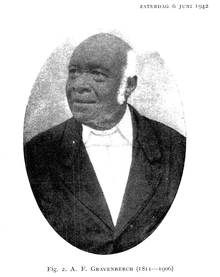Adolf Frederik Gravenberch
Adolf Frederik Gravenberch (born February 1, 1811 on the Clarenbeek plantation in Commewijne , † November 16, 1906 in Paramaribo ) was a slave born and probably the first doctor of African descent in the Dutch colony of Suriname .
Live and act
Adolf Frederik was born on the Clarenbeek plantation, 52 years before the Netherlands abolished slavery. Clarenbeek was a sugar cane plantation on the left bank of the Commewijne that had existed since 1671 . In 1821, the Suriname Almanac reported that the plantation had been abandoned. At that time the property belonged to the brothers S. and SH de la Parra.
Paramaribo
At the age of 15, Adolf Frederik was given by his owner S. de la Parra as an assistant to the doctor Gottlieb August Steglich (1766–1738), who was born in Zittau . Steglich ran a large hospital in Paramaribo. When Steglich fell ill, he gave the boy to his friend and colleague Dr. George Cornelis Berch Gravenhorst, who also had his own hospital in Paramaribo, on Gravenstraat. Here Adolf Frederik deepened his medical knowledge and was finally employed as an assistant doctor.
Even this “career” is remarkable, since until 1844 it was forbidden to give school lessons to slaves. Even after that it was still forbidden to teach slaves Dutch - the official language - and it was not until 1856 that they were allowed to be given writing lessons in Suriname.
In the first half of the 19th century, instruction among the slave population was primarily provided by missionaries from the Moravian Brethren . It was mainly limited to Christian content and was only given in the Creole language Sranantongo .
That Adolf Frederik had never really learned to read and write Dutch as a result, was later reproached him.
Ransom
Adolf Frederik had to cede the wages he earned for his work to his owner, who, however, left part of it to him. After Adolf Frederik had saved enough, he was able to acquire a manumissie letter (derived from manumissio , a term from Roman law) through the mediation of Berch Gravenhorst and thus buy himself free from slavery in the government. When he entered the civil register, he chose the surname Gravenberch - this probably out of a mutual respect between the teacher and the former slave apprentice.
According to the database of the Nationaal Archief in The Hague , four years later, in 1846, Adolf Frederik Gravenberch acquired ransom letters for the domestic worker Adolphina Margaretha and six children, who were also given the surname Gravenberch . Presumably these are his wife and their children, but certainly blood relatives .
From 1832 onwards, children had to be paid 250 guilders , slaves older than 40 years 400 guilders and all other slaves 500 guilders to the public purse. Another requirement for the Manumissie was that you had to be a registered member of a recognized religious community. Two years after receiving the Manumissie letter , freedmen could claim civil rights, provided they were able to present a declaration of their impeccable behavior during these two years.
doctor
After two rejected applications, Gravenberch was given permission to practice medicine by royal resolution Honoris causa in 1855 . At that time - eight years before emancipation - it was a sensational event that met resistance in colonial society, because the Commission for Health Care had again spoken out against the approval of Afro-Surinamers. In a letter to the governor von Schmidt auf Altenstadt , the main complaint was that Gravenberch could hardly read and write and could only express himself in Sranantongo. So he could not possibly study the theory of medicine. The governor replied that he considered it a disrespectful presumption to insinuate that the king had not properly considered all the circumstances before making his decision. This worked - the commission hurried to enroll Gravenberch on August 1, 1855 as a member of the Medicus College.
A short time later, Gravenberch opened his own doctor's practice in Paramaribo. He continued his profession well into old age and died in 1906 after a short illness.
In Paramaribo, the Gravenberchstraat is a reminder of the former slave and later doctor.
literature
- CFA Bruijning, J. Voorhoeve (main editor): Encyclopedie van Suriname . Elsevier , Amsterdam a. Brussel 1977, ISBN 90-10-01842-3 , p. 255.
Individual evidence
- ^ De Surinamer dated November 18, 1906, family report, Dutch obituary notice , accessed January 10, 2017.
- ^ Algemeen Handelsblad dated December 13, 1906, obituary for Gravenberch in Dutch, accessed on January 10, 2017.
| personal data | |
|---|---|
| SURNAME | Gravenberch, Adolf Frederik |
| ALTERNATIVE NAMES | Adolf Frederik (maiden name) |
| BRIEF DESCRIPTION | Slave and doctor in Suriname |
| DATE OF BIRTH | February 1, 1811 |
| PLACE OF BIRTH | Commewijne , Suriname |
| DATE OF DEATH | November 16, 1906 |
| Place of death | Paramaribo , Suriname |
